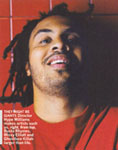|
|||
|
I’m known for the fish-eye lens. When I started directing hip-hop videos, everyone said, “This guy took our world and made it look huge,” but that’s just because of the perspective I get with the wider lens. I always saw superstardom in my friends. They had to be the same size in their music and performance ability as Madonna, Bruce Springsteen, Billy Idol and all those big music-video icons on MTV. I wanted rap to have that same kind of size, because I knew in my heart that it was just as big – if not bigger. I’m the biggest fan there is. It’s through the lens of the camera that I’m able to paint my picture. The camera is the housing to the glass. I shoot eight-millimeter and ten-millimeter film. We do everything with a Steadicam, dolly or crane, but the equipment is really secondary. It’s all about the lens and where you put it, not what’s the fanciest camera and all that. I shoot low angles on women – for example, TLC. I shoot them low because they’re all short, maybe five feet tall, so why would want to see them as little girls? I want to see them as giants because that’s what they are, so I shoot them low angle with these way distorted lenses and they look ten feet tall. R. Kelly, same thing. We always make selective choices of how he is shot because we want him to have that larger-than-life look that the Backstreet Boys and Britney Spears and all those guys have now. I don’t like a lot of the stuff that I’ve done, but my first video, Wu-Tang’s “Can It All Be So Simple?” helped me understand what I was trying to accomplish – creating a complete marriage between a song and an image. With that video, I knew what I wanted to do with my talent, whatever that is, was to take black music and deliver images that were married to the song. I got a couple of videos like that, like Busta Rhymes’s “Woo-Hah! Got You All in Check.” For Busta I used wide-angle lenses because he is very animated, a very extreme artist, and I was able to exaggerate his already exaggerated movements. And Missy Elliott for her “The Rain (Supa Dupa Fly)” video. I was such a fan of all these big French filmmakers and all the Grace Jones projects that redefined the black woman on film and in music that I wanted Missy to have an identity like Grace Jones’s. Something very new and very different and very European. When we did her wide-angle stuff, we nailed a specific look for her, and that was really her launchpad. We made those videos look exactly how we felt about the performances in the songs. I’m from Hollis, Queens. I went to Catholic school with Run-D.M.C. and high school with LL Cool J. Hip-hop was the era I grew up in. And I’ve loved films my whole life. I used to watch The Godfather maybe once a week when I was 14. I’d watch Scarface two or three times a week, Akira Kurosawa’s Dreams, Once Upon a Time in America, all the Italian gangster films, but I also used to watch the Star Wars movies and comedies such as Bachelor Party and Weird Science. For me, visuals are everything. I don’t think anyone thought the music was going to be a vehicle to this extreme. No one could have foreseen that hip-hop was going to be a world culture – everyone from that era just did what he knew how to do and it became what it became. |
